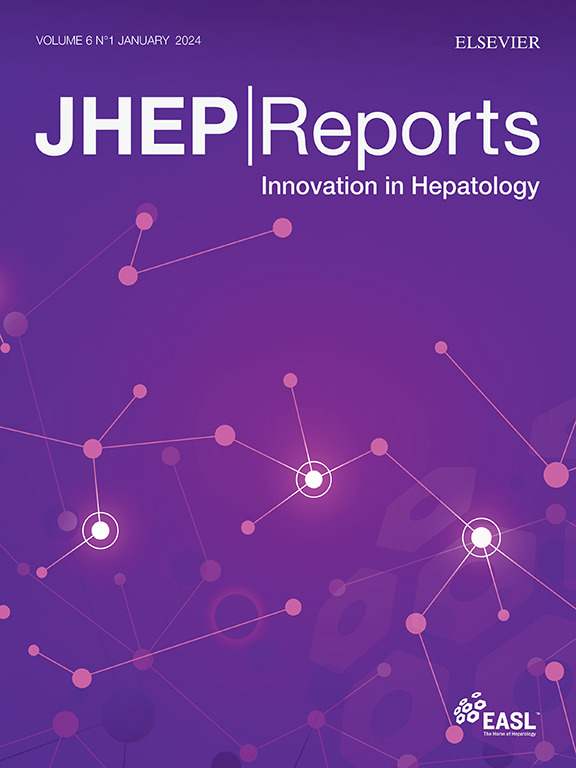常见小鼠品系在MASH和肝癌模型中的肝脏免疫环境差异
IF 9.5
1区 医学
Q1 GASTROENTEROLOGY & HEPATOLOGY
引用次数: 0
摘要
背景,aimsinx杂交小鼠系是研究代谢功能障碍相关脂肪性肝炎(MASH)和肝细胞癌(HCC)免疫调节的重要工具。在这里,我们描述了小鼠品系相关的肝脏免疫差异,并进行了小鼠-人类跨物种免疫比较。方法采用高维光谱流式细胞术比较C57BL/6、BALB/c和FVB/N小鼠在健康、MASH和HCC状态下的免疫景观(每种状态N = 4)。饲粮缺乏蛋氨酸和胆碱或西餐+四氯化碳诱导MASH。通过水动力质粒注射MYC/sg-p53引起HCC。使用公共小鼠和人类scRNA-seq数据集进行验证和跨物种比较。结果健康小鼠的肝脏CD4+ T(24%比14%比34%,p <0.05)和B细胞(36.5%比35%比18%,p <0.05)差异最大。C57BL/6小鼠TH1显性,BALB/c和FVB/N小鼠TH2显性(log[TH1:TH2] = 0.17, -0.31, -0.17)。在MASH小鼠中,肝髓细胞和先天淋巴细胞的扩增是常见的,但B细胞(log(fold-change) = -0.38, -0.28, -0.58, p <0.05)和T亚群(如CD4+ T log(fold-change) = -0.21, -0.07, -0.15, p <0.05)的变化在不同菌株之间差异很大。MYC/sg-p53 HCC诱导肝脏Tregs和CD8+ T细胞持续扩增(p <0.05),但不同菌株的肝脏免疫景观发生差异。流式细胞术数据由匹配C57BL/6背景的公共scRNA-seq数据集支持。进一步在MASH条件下的跨物种比较证实了小鼠和人类之间适应性淋巴细胞的共同变化。在两种MASH模型中,BALB/c或C57BL/6小鼠分别更一致地恢复CD4+ T细胞或B细胞的损失(p <0.05)。结论不同小鼠品系间肝脏免疫存在较大差异。小鼠可以随着菌株的变化重现人类肝脏的某些免疫变化。影响和意义我们的免疫细胞谱研究表明,无论是在健康状态还是病理状态(如脂肪性肝炎或肿瘤过程)下,普通小鼠品系的肝脏免疫环境都可能存在很大差异。我们的研究结果为肝脏免疫学研究提供了数据资源,并为设计小鼠肝脏中各种免疫细胞的研究提供了有价值的见解。本文章由计算机程序翻译,如有差异,请以英文原文为准。

Hepatic immune environment differences among common mouse strains in models of MASH and liver cancer
Background & Aims
Inbred mouse strains are critical tools for studying immune regulation of metabolic dysfunction-associated steatohepatitis (MASH) and hepatocellular carcinoma (HCC). Here, we profiled mouse strain-associated hepatic immune differences, and performed mice–human cross-species immune comparisons.
Methods
Immune landscapes of C57BL/6, BALB/c, and FVB/N mice were compared under healthy, MASH, or HCC state using high-dimensional spectral flow cytometry (n = 4 per condition). MASH was induced by feeding methionine- and choline-deficient or Western diet + carbon tetrachloride. HCC was caused by hydrodynamic plasmid injection of MYC/sg-p53. Public mouse and human scRNA-seq datasets were used for validation and cross-species comparisons.
Results
In healthy mice, liver CD4+ T (24% vs. 14% vs. 34%, p <0.05) and B cells (36.5% vs. 35% vs.18%, p <0.05) varied the most among three strains. C57BL/6 mice showed TH1 dominance, whereas BALB/c and FVB/N mice had TH2 dominance (log[TH1:TH2] = 0.17, -0.31, -0.17). In MASH mice, expansion of liver myeloid cells and innate lymphocytes were commonly found, but changes of B cells (log(fold-change) = -0.38, -0.28, -0.58, p <0.05) and T subsets (e.g. CD4+ T log(fold-change) = -0.21, -0.07, -0.15, p <0.05) varied greatly among strains. MYC/sg-p53 HCC induced a consistent expansion of liver Tregs and CD8+ T cells (p <0.05), but differential shifts of liver immune landscape were seen among strains. The flow cytometry data was supported by public scRNA-seq datasets matching C57BL/6 background. Further cross-species comparison in MASH condition confirmed shared changes of adaptive lymphocytes between mice and humans. In two MASH models, BALB/c or C57BL/6 mice were more consistent to recapture loss of CD4+ T or B cells, respectively (p <0.05).
Conclusions
Substantial liver immune differences exist among common mouse strains. Mice can recapitulate certain human liver immune changes with strain variations.
Impact and implications
Our immune cell profiling study revealed that the liver immune environment can be quite different among common mouse strains both under healthy and pathologic states, such as steatohepatitis or neoplastic processes. Our results serve as a data resource for studies investigating liver immunology and provide valuable insights for the design of studies on various immune cells in the livers of mice.
求助全文
通过发布文献求助,成功后即可免费获取论文全文。
去求助
来源期刊

JHEP Reports
GASTROENTEROLOGY & HEPATOLOGY-
CiteScore
12.40
自引率
2.40%
发文量
161
审稿时长
36 days
期刊介绍:
JHEP Reports is an open access journal that is affiliated with the European Association for the Study of the Liver (EASL). It serves as a companion journal to the highly respected Journal of Hepatology.
The primary objective of JHEP Reports is to publish original papers and reviews that contribute to the advancement of knowledge in the field of liver diseases. The journal covers a wide range of topics, including basic, translational, and clinical research. It also focuses on global issues in hepatology, with particular emphasis on areas such as clinical trials, novel diagnostics, precision medicine and therapeutics, cancer research, cellular and molecular studies, artificial intelligence, microbiome research, epidemiology, and cutting-edge technologies.
In summary, JHEP Reports is dedicated to promoting scientific discoveries and innovations in liver diseases through the publication of high-quality research papers and reviews covering various aspects of hepatology.
 求助内容:
求助内容: 应助结果提醒方式:
应助结果提醒方式:


